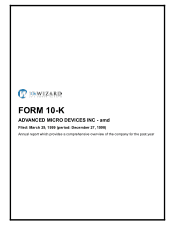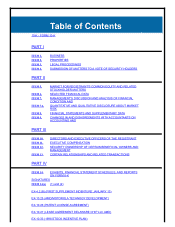AMD 1998 Annual Report Download - page 7
Download and view the complete annual report
Please find page 7 of the 1998 AMD annual report below. You can navigate through the pages in the report by either clicking on the pages listed below, or by using the keyword search tool below to find specific information within the annual report. A discussion of the principal parts of the digital IC market in which we
participate follows.
The Microprocessor Market
The microprocessor, an IC generally consisting of millions of transistors,
serves as the central processing unit, or brain, of a computer system. The
microprocessor is typically the most critical component to the performance and
efficiency of a PC. The microprocessor controls data flowing through the
electronic system and manipulates such data as specified by the hardware or
software which controls the system. In 1981, IBM introduced its first PC
containing a microprocessor based upon the x86 instruction set developed by
Intel Corporation and utilizing the Microsoft(R) Corporation MS-DOS(TM)
operating system. As circuit design and very large scale integration process
technology have evolved, performance and functionality of each new generation
of x86 microprocessors have increased.
The microprocessor business is characterized by short product life cycles,
intense price competition and rapid advances in product design and process
technology. Today, the greatest demand for microprocessors is from PC
manufacturers and, in particular, for microprocessors which are Microsoft
Windows(R) compatible and are based on the x86 instruction set. Improvements
in the performance characteristics of microprocessors and decreases in
production costs resulting from advances in process technology have broadened
the market for PCs and increased the demand for microprocessors. The
microprocessor market is currently dominated by Intel.
The establishment of hardware and software standards for PCs and the
emergence of numerous PC suppliers have caused the PC industry to be extremely
competitive, with short product life cycles, limited product differentiation
and substantial price competition. To compete more effectively, most PC
suppliers have evolved from fully integrated manufacturers with proprietary
system designs to vendors focused on building brand recognition and
distribution capabilities. Almost all of these suppliers now rely either on
Intel or on third-party manufacturers for the major subsystems of their PCs,
such as the motherboard. These suppliers are also increasingly outsourcing the
design and manufacture of complete systems. The third-party manufacturers of
these subsystems, based primarily in Asia, are focused on providing PCs and
motherboards that incorporate the latest trends in features and performance at
low prices. Increasingly, these third-party manufacturers are also supplying
fully configured PC systems through alternative distribution channels.
Embedded processors are also an important segment of the microprocessor
market. Embedded processors are general purpose devices used to carry out a
single application with limited user interface and programmability. A system
designed around an embedded processor usually cannot be programmed by an end
user because the system is preprogrammed to execute a specific task. Key
markets for embedded processors include telecommunications, networking, office
automation, storage, automotive applications and industrial control.
The Memory Market
Memory ICs store data or programs and are characterized as either volatile
or non-volatile. Volatile devices lose their stored information after
electrical power is shut off, while non-volatile devices retain their stored
information. The three most significant categories of semiconductor memory are
(1) Dynamic Random Access Memory (DRAM) and (2) Static Random Access Memory
(SRAM), both of which are volatile memories, and (3) non-volatile memory,
which includes Read-Only Memory (ROM), Flash memory and Erasable Programmable
Read-Only Memory (EPROM) devices. DRAM provides large capacity main memory,
and SRAM provides specialized high-speed memory. Flash and other non-volatile
memory devices are used in applications in which data must be retained after
power is turned off. We do not produce any DRAM products, which are the
largest segment of the memory market, or SRAM products.
Several factors have contributed to an increasing demand for memory devices
in recent years, including:
. the expanding unit sales of PCs in the business and consumer market
segments;
. the increasing use of PCs to perform memory-intensive graphics and
multimedia functions;
4
Source: ADVANCED MICRO DEVIC, 10-K, March 29, 1999




















